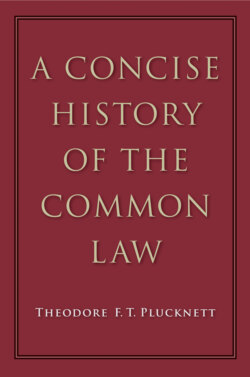Читать книгу A Concise History of the Common Law - Theodore F. T. Plucknett - Страница 61
На сайте Литреса книга снята с продажи.
THE HABEAS CORPUS ACT
ОглавлениеThe period from 1660 to the Revolution of 1689 is, however, more remarkable for its contributions to public than to private law. The one other great legal reform of the reign of Charles II was the passing of the Habeas Corpus Act2 in 1679. The writ of habeas corpus has played such a large part in the struggle for liberty that a short history of it must be given here.3 Like a good many other common law writs, its history can be traced back to the early age when legal procedure and administrative methods were still not distinguished, and, together with the other prerogative writs of mandamus, certiorari and the rest,4 its ultimate origin is in a simple command from the Crown to one of its officials. In the reign of Edward I there were several varieties of habeas corpus serving different purposes, such as to secure the appearance of a defendant or of jurymen. Gradually the courts acquired the habit of issuing the writ in order to bring before them persons who had been committed by inferior jurisdictions—particularly the courts of cities and local franchises. The motive of this policy seems to have been to enlarge the powers of the Courts of Westminster at the expense of local tribunals, and the result was not infrequently confusion and injustice. Parties were even allowed to use this process when they had been committed by judgment of local courts for debt so as to obtain their release and to defraud their creditors. It is not surprising, therefore, to find a steady stream of legislation restricting the scope of habeas corpus.
At the end of the fifteenth century the common law courts had nothing more to fear from local jurisdictions. A new antagonist appeared in the form of Chancery, followed soon after by the Courts of Requests and Star Chamber. The writ of habeas corpus was now turned against this larger game. The common law courts were indignant when Chancery committed parties for suing at common law after they had been enjoined, and Chief Justice Huse proposed to release such prisoners by means of habeas corpus (1482).5 The Courts of Admiralty and High Commission were similarly attacked, but it was in the seventeenth century that habeas corpus fought its greatest battle. The Crown had established the right of imprisoning without trial upon a warrant signed by the Secretary of State and a few Privy Councillors, alleging “her Majesty’s special commandment”.6 Against so serious a claim of State absolutism habeas corpus became in the words of Selden “the highest remedy in law for any man that is imprisoned”.
Throughout the Stuart period habeas corpus was steadily used and improved by the courts of common law. But procedural difficulties stood in the way. Darnel’s Case1 had shown doubts; the special command of the King was nevertheless there held to be a sufficient return, and this rule was only abolished by the Petition of Right.2 There were also doubts as to which courts were competent to issue it. Many of these defects were remedied in the Habeas Corpus Act3 of 1679, which after much discussion finally passed the House of Lords—and then only owing to a mistake in the counting of the votes, so the story goes. By this act any judge during term or vacation must issue the writ unless the prisoner is obviously committed by lawful means. Prisoners are not to be imprisoned beyond the realm, and the writ is to run in all privileged places. Later legislation at various dates introduced still further improvements. Some striking examples of its use in more modern times are Sommersett’s Case,4 where a writ of habeas corpus released a negro slave from confinement in a ship on the Thames, on the ground that an allegation of slavery was not a sufficient return. In 1798 the writ was used to ensure a trial at common law of a prisoner, Wolfe Tone, who had been condemned by a court-martial.5
